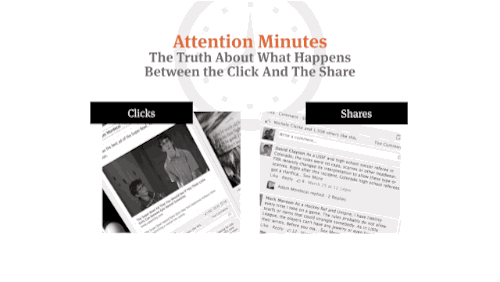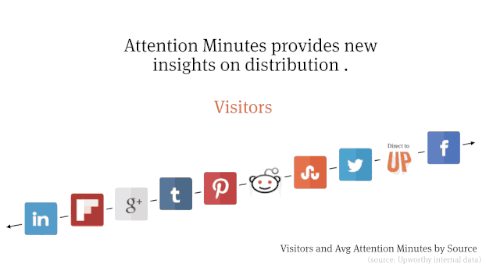The Code [Literally] To What Lies Between The Click And The Share. Yours, For Free… Really.
In the age of ever-present social media, our collective attentions have never been spread thinner. According to Facebook, each user has the potential to be served 1,500 stories in their newsfeed each time. For a heavy user, that number could be as much as 15,000. In this climate, how do you get people to pay attention? And, more importantly, how do you know they're actually engaged?
Clicks and pageviews, long the industry standards, are drastically ill-equipped for the job. Even the share isn’t a surefire measure that the user has spent any time engaging with the content itself. It’s in everyone’s interest — from publishers to readers to advertisers — to move to a metric that more fully measures attention spent consuming content. In other words, the best way to answer the question is to measure what happens between the click and the share. Enter Attention Minutes.

We've previously detailed our intention to switch the way we measure user engagement to a more nuanced, holistic measure. In brief, Attention Minutes measures everything from video player signals about whether a video is currently playing to a user’s mouse movements to which browser tab is currently open — all to determine whether the user is still engaged. The result is a fine-grained and unforgiving metric that tells us whether people are really engaged with our content or have moved on to the next thing. Today, we’re publicly releasing sample code for Attention Minutes.
You’re more than welcome to use our code as a starting point to build Attention Minutes into your system, but if you’re not in a place to do that (it requires a bit of engineering and a data processing system), Chartbeat has a great out-of-the-box solution as well. We’re also happy to announce that Parse.ly, one of the finest platforms for online content measurement, is going to start using our Attention Minutes code for all of their clients:
“The vision behind Upworthy’s Attention Minutes push has gotten us very excited to include this capability in our platform for all our clients — everyone should be looking at a clean signal for attention,” said Andrew Montalenti, CTO of Parse.ly. (Parse.ly is a provider of content analytics solutions for publishers whose clients include Conde Nast, Fox News, Atlantic Media, and The Cheezburger Network.)
Attention Minutes is the next step in engagement metrics, but it’s not the first attempt to measure attention on the Internet. Our work adds to what several forward-thinking publishers and third-party platforms have already put forward. Publishers like Say Media have been using their Total Engaged Time metric as a key signal driver for quality on publications like xoJane, Remodelista, Bio.com, and Readwrite. Medium has championed measuring and optimizing for engagement and has recently started experimenting with incentivizing its editors based on total time spent reading. The folks at Chartbeat have also been talking about the “Attention Web” for some time now and are onboard with Attention Minutes:
“Upworthy are among the first publishers really committing to understanding and monetizing attention — and adapting their business to do so. They know the future of the web needs to be about more than driving traffic to a story. It has to be about placing a premium on stories that capture and hold people’s attention, and we’re excited to have them as partners in this mission,” said Tony Haile, CEO of Chartbeat, which is measuring and monetizing attention in real time for editorial and advertising teams with its engaged time metrics.
We know it can be a little difficult to get your head around any new metric. So we put together the following GIFs that help explain a few hidden things that Attention Minutes help reveal about both content and distribution.

Here’s a quick payoff to measuring Attention Minutes: We know that you’ll probably be into these two videos because, even in a crop of other videos that people loved, these two were significantly more likely to grab and take hold of viewer’s attention.
- A Gorgeous Woman Shakes Her Body On Stage … And The Crowd Goes Wild
- A French Film Showing Men What Being A Woman Feels Like Kinda Nails It

The old paradigm of pageviews is giving way to cleaner signals for attention. Our conversations with clients — from brands to advertisers — all point toward a hunger for real engagement measurements that capture whether users are actually tuning in to content. And we’re not the only ones seeing this appetite. Just this week Financial Times announced it will be selling ads based on the time its audience spends with the content. After all, what’s the use of a big-budget advertising campaign if you can’t even tell whether people are noticing?
This development is a good thing. The more we’re measuring for engagement and satisfaction instead of being distracted by pageview-juking slideshows, zombie tabs, and the like, the more we can create real, sustainable incentives to make quality content.
So, feel free to use our code as a starting point. Or, if you don’t have the wherewithal to build, Chartbeat (and soon Parse.ly) have off-the-shelf products you can use today. In any case, the excuses for using old-school, limited measurements are rapidly disappearing. And, frankly, we think the Internet will be all the better for it.


